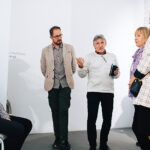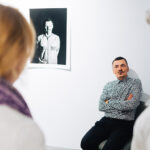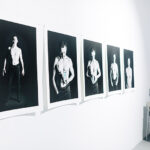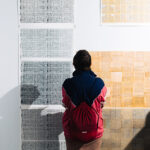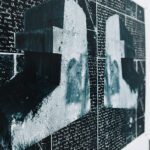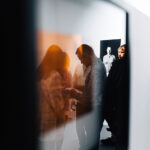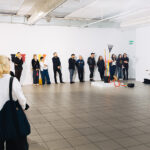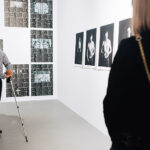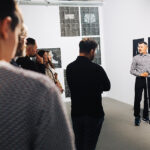Current and announcment
Grzegorz Frydryk’s exhibition ‘o nieustannej modlitwie’ (About Perpetual Prayer)
“I found abandoned matrixes at the university – unwanted and forgotten. There were four matrixes, all the same format. I covered them with varnish and wrote the text of perpetual prayer on them in mirror reflection. Simple words, sincere invocation. They encompass the fullness of faith. I placed the matrixes together on the press bed and made a print. Laid side by side, they began a graphic narrative of perpetual prayer. The words of this prayer have accompanied me for several years. They are comforting, guiding me through difficult times and giving me hope. In today’s world, we are surrounded by a constant flood of various words and information. This prayer is the opposite – it is sincere and simple.”
Grzegorz Frydryk
In the beginning was the word, the word became the text of prayer, and prayer became the matrix. The phenomenon of spoken and written language, with its ability to tell stories and convey complex ideas, distinguishes the human world from the animal world. Writing, deeply rooted in human history, plays a key role in communication, the transmission of information, the preservation of knowledge and the expression of thoughts and feelings. And although, at first glance, it would seem that the speech of the visual arts is based on images and forms, writing can be an equally important element of artistic composition. The visual arts know many artists who use writing as the main means of artistic expression, recalling, for example, the Surrealists, who believed that the technique of automatic writing allowed for the expression of deeply hidden unconscious dreams and emotions, and provided an opportunity for the free flow of thoughts that appear in the artist’s mind. Grzegorz Frydryk is an artist who undertakes experiments combining the written word and visual arts. He creates works that surprise not only with their visual aspect, but above all with a kind of fixation on one motif – a fragment of the prayer ‘Lord, have mercy’.
In the artist’s graphic works, the written word mixes with the image, and at times even dominates it. White sheets of paper are then covered with repeated lines of handwritten (almost ‘scribbled’) words. In the artist’s own words: ‘From my dysgraphia handwriting I decided to create something graphic. The non-graphic becomes graphic, achieving an artistic form’. The sheets of paper covered with densely packed scribbled lines are reminiscent not so much of an artistic concept of horror vacui, as of a kind of obsession with the sentence, which ceases to be a series of signs and grows to become a symbol. A simple verbal declaration (or perhaps a request or supplication) takes on the characteristics of an artistic mantra: ‘Lord Jesus Christ, have mercy on me’ – suffering, experienced, looking fearfully to the future. The words of the prayer move like beads in a rosary. Could there be anything more intimate than a confession of faith that becomes an attempt to spell reality and a struggle against what is destined for us?
Grzegorz Frydryk, experiencing a difficult illness, seems to have found partial solace in the second series of works presented at the exhibition. The sequence of black and white photographic self-portraits is a courageous confession, or even an exposure of the effects of Parkinson’s disease. Beneath the bare, pale skin of his chest, the outline of a rectangular device can be seen. The implanted component is an electrical stimulator – a small device used in therapy for deep brain stimulation (DBS*) – directly connected to him. This begs the question: who am I now? ‘Am I already a cyborg or just an enhanced version of a human being?’ – asks the artist, who includes a panoramic X-ray of his own head in one of his prayer graphics. It was here that he first saw the effects of an operation to implant electrodes stimulating his brain. An exhibition ‘about constant prayer’ will probably not be an experience of beauty and harmony. But art ultimately also touches on those slices of reality that are difficult to accept and embrace. Nevertheless, it is a story about faith and hope, without which life would be unbearable.
Curator Olga Kasztalewicz
* The first DBS treatment for Parkinson’s disease was performed in 1993 in France. Soon afterwards, it began to be used in other countries, including Poland. The implanted electrodes generate electrical impulses that modify the activity of the nerve centres responsible for the development of the disease. A battery (pulse generator) placed in the patient’s body provides a constant source of current. The parameters of the current are very low and its voltage rarely exceeds 4 V. These treatments are becoming increasingly popular. They are performed not only in Parkinson’s disease, but also in many other movement disorders, such as spontaneous tremor or dystonia. Currently, there are already about 130,000 people in the world living with a brain stimulator.

Grzegorz Frydryk
Born in 1976 in Rzeszów. Graduate of the State Secondary School of Fine Arts in Rzeszów. In 1997–2002 he studied in the Institute of Fine Arts at the University of Rzeszów. Received his diploma in 2002 in the Painting Studio of Prof. Irena Popiołek-Rodzińska and in the Graphic Arts Studio of Prof. Andrzej Pietsch. Since 2006, assistant in the Department of Printmaking at the Faculty of Art of the University of Rzeszow in the Gravure Print Studio of Prof. Włodzimierz Kotkowski, and then in the Convex Print Studio of Prof. Krzysztof Skórczewski. In 2012, PhD at the Faculty of Graphic Arts, Academy of Fine Arts in Katowice. Habilitation at the Academy of Fine Arts in Katowice in 2023. He is currently working as a Ph.D. prof. at University of Rzeszów, in the Studio of Relief Printing in the Department of Artistic Printmaking and Art Theory of the Institute of Fine Arts. He works with printmaking, drawing and painting. Author of graphic works, books and poetry volumes. Member of the ‘Fraza’ literary and artistic association and the Association of International Graphic Art Triennial in Kraków.



